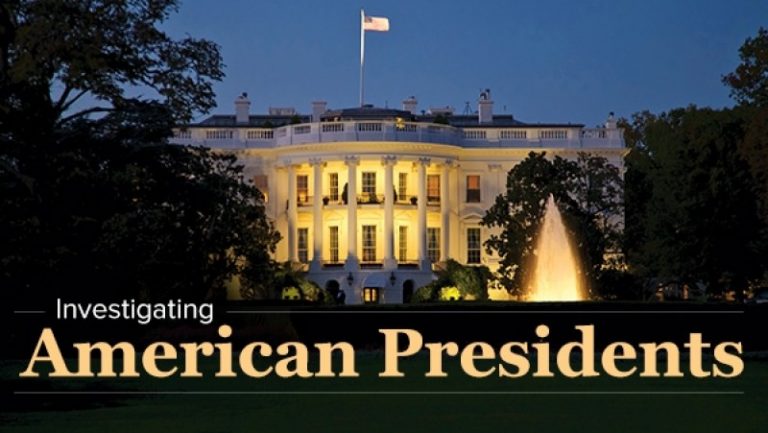History does not repeat itself but it rhymes.
The American president is a uniquely powerful figure on the national stage—indeed, on the world stage. He or she holds sway over an executive branch whose responsibilities range from national defense to agricultural price supports and on to health, education, and tax policy.
But, as the saying goes, power corrupts. It is not unheard of in American history for presidents to wield their significant powers in ways that are contrary to law or that call into question their fitness for office. What happens when presidents or their administrations are thought to have engaged in misconduct or the abuse of their powers?
When the president does it, that means that it is not illegal. – Richard Nixon
The Course explores how law, policy, and history can guide our response to presidential abuse, and considers whether the institutions of American democracy are robust enough to constrain a president who engages in misconduct. These issues, so salient in the past, are once again at the forefront of Americans’ minds.
The course also examines unique advantages that presidents have in responding to investigations of their conduct. They have, for example, an executive privilege which can be used to shield confidential executive communications—at least some of the time. Presidents also have the power of the bully pulpit, which is the ability to command attention and vilify their prosecutors or change the topic to whatever suits them better.
Here are my favourite take aways from viewing Professor Paul Rosenzweig’s Great Courses Class: Investigating American Presidents:
The Imperial Presidency
- Imperial Presidency is a term applied to the modern presidency of the United States. It became popular in the 1960s and served as the title of a 1973 book by historian Arthur M. Schlesinger, Jr., who wrote The Imperial Presidency to address two concerns: that the presidency was uncontrollable and that it had exceeded its constitutional limits.
Investigating Presidential Conduct
- The power to investigate a sitting president is the power to limit his or her authority and thereby rein in the potential for abuse. It is also the power to restrict the president’s legitimate exercise of authority for illegitimate reasons. And therein lies a fundamental paradox: Democratic nations understand the need for executive effectiveness and want security, but they also want transparency, accountability, and some control over executive behavior.
The Impeachment of Andrew Johnson
Andrew Johnson succeeded Abraham Lincoln after Lincoln was assassinated. Despite his pro-Union tendencies, Johnson did everything in his power to frustrate Congress’s plans for Reconstruction—that is, their plan to rebuild the South. He vetoed both the Civil Rights Act and the 14th Amendment, which granted ex-slaves the rights of other citizens to equal protection under the law.
Republicans in Congress wanted to rein in Johnson and keep in place cabinet members who were loyal to Lincoln and the idea of Reconstruction, so they passed the Tenure of Office Act, which prohibited the president from firing anyone in his administration without Senate approval.
In February 1868, Johnson fired the secretary of war, Edwin Stanton, who was committed to southern Reconstruction. Johnson’s firing of Stanton set up a direct confrontation with Congress, because it clearly violated the Tenure of Office Act.
The House of Representatives voted overwhelmingly to impeach Johnson. Following constitutional requirements, the Senate spent much of April 1868 holding an impeachment trial. In May, however, the Senate failed to convict him. The final vote was 35 votes of guilty and 19 of not guilty, which was one vote short of the two-thirds majority that the Constitution required. Johnson was acquitted and served out the remainder of his term.
Scandals
The Whiskey Ring
- The Whiskey Ring was a scheme in which the distillers paid a bribe of 35 cents per gallon to various officials within the revenue service, who then issued the necessary tax stamps. In effect, the distillers were able to reduce their tax bill by half and pocket the remainder as profit.
The Teapot Dome scandal
- The Teapot Dome scandal was a bribery scandal involving the administration of United States President Warren G. Harding from 1921 to 1923. Secretary of the Interior Albert Bacon Fall had leased Navy petroleum reserves at Teapot Dome in Wyoming, as well as two locations in California, to private oil companies at low rates without competitive bidding. The leases were the subject of a seminal investigation by Senator Thomas J. Walsh. Convicted of accepting bribes from the oil companies, Fall became the first presidential cabinet member to go to prison; no one was convicted of paying the bribes.
Albert Bacon Fall became the first presidential cabinet member to go to prison; no one was convicted of paying the bribes.
The Watergate Scandal
The Watergate scandal was a political scandal in the United States involving the administration of U.S. President Richard Nixon from 1972 to 1974 that led to Nixon’s resignation. The scandal stemmed from the Nixon administration’s continuous attempts to cover up its involvement in the June 17, 1972 break-in of the Democratic National Committee headquarters at the Washington, D.C. Watergate Office Building.
After the five perpetrators were arrested, the press and the U.S. Justice Department connected the cash found on them at the time to the Nixon re-election campaign committee. Five months after the break-in, in November 1972, Nixon was reelected in a landslide. In January 1973, the five burglars were convicted of conspiracy and burglary. Then the investigation spun out of control.
President Richard Nixon (1913–1994) was the first US president to resign from office.
The Impeachment of Bill Clinton
The specific charges against Clinton were lying under oath and obstruction of justice. The charges stemmed from a sexual harassment lawsuit filed against Clinton by Paula Jones and from Clinton’s testimony denying that he had engaged in a sexual relationship with White House intern Monica Lewinsky.
On December 19, 1998, Clinton became the second American president to be impeached (the first being Andrew Johnson, who was impeached in 1868), when the House formally adopted two articles of impeachment and forwarded them to the United States Senate for adjudication; two other articles were considered but were rejected.
Clinton thus became the second U.S. president to be impeached; the first, Andrew Johnson, was impeached in 1868.
Clinton was impeached by the House of Representatives on December 19, 1998 on grounds of perjury to a grand jury (first article, 228–206) and obstruction of justice (third article, 221–212). The two other articles were rejected, the count of perjury in the Jones case (second article, 205–229) and abuse of power (fourth article, 148–285). Clinton remained in office for the remainder of his second term.
Clinton was held in civil contempt of court by Judge Susan Webber Wright for giving misleading testimony in the Paula Jones case regarding Lewinsky and was also fined $90,000 by Wright. His license to practice law was suspended in Arkansas for five years; shortly thereafter, he was disbarred from presenting cases in front of the United States Supreme Court.
Can a sitting president be indicted?
The Indictment of Spiro Agnew (Richard Nixon’s VP)
- It is clear that everyone except the sitting president of the United States is subject to the same law and can be indicted. In the 1970s, Vice President Spiro Agnew was investigated for tax fraud and corruption relating to his service as governor of Maryland. The case against Agnew was a strong one. One witness was willing to testify that he had made cash payments to Agnew. Another, the former chair of Maryland’s Road Commission, had kept detailed records and documentation laying out the corrupt payments that had been made to Agnew.
- Agnew was eventually indicted, and on October 10, 1973, he pled no contest to tax evasion before a federal court in Baltimore. He did get a good deal. Attorney General Richardson did not charge Agnew with any other crimes.
Agnew paid only a $10,000 fine, and he was placed under three years of unsupervised probation.
Precedents on the presidents indictability
- The United States v. Nixon
- Clinton v. Jones
- Nixon v. Fitzgerald
Presidential Pardons
- Jimmy Carter issued a sweeping pardon for all the Vietnam war resisters, many of whom had fled to Canada.
- Richard Nixon’s commutation of the sentence of Teamster boss Jimmy Hoffa, allegedly to secure Hoffa’s political endorsement.
- The pardon can also be used for a presumptive case, such as when President Gerald Ford pardoned Nixon, who had not been charged with anything, over any possible crimes connected with the Watergate scandal
- Bill Clinton pardoned 140 people on his last day in office, January 20, 2001, including billionaire fugitive Marc Rich and his own brother, Roger Clinton.
- President Donald Trump issued his first pardon to former Arizona sheriff Joe Arpaio on August 25, 2017. Arpaio had been convicted of criminal contempt in federal court.
Movie
- Wag the Dog
The screenplay concerns a spin doctor and a Hollywood producer who fabricate a war in Albania to distract voters from a presidential sex scandal. The movie stars Dustin Hoffman and Robert De Niro.
Recommended Reading
- The Imperial Presidency by Authur M. Schlesinger Jr.
- Investigating the President: Congressional Checks on Presidential Power
- Grant. by Ron Chernow
- Centennial Crisis: The Disputed Election of 1876 by William H. Rehnquist
- “Graft and Oil: How Teapot Dome Became the Greatest Political Scandal of Its Time.”
- All the President’s Men by Bob Woodward
- The Death of American Virtue: Clinton vs. Starr by Ken Gormley,
- Truth at Any Cost: Ken Starr and the Unmaking of Bill Clinton by Susan Schmidt
- Can the President Be Indicted? A Long-Hidden Legal Memo Says Yes by Charles Savage
- Impeachment: An American History by Jon Meacham




Comments are closed.